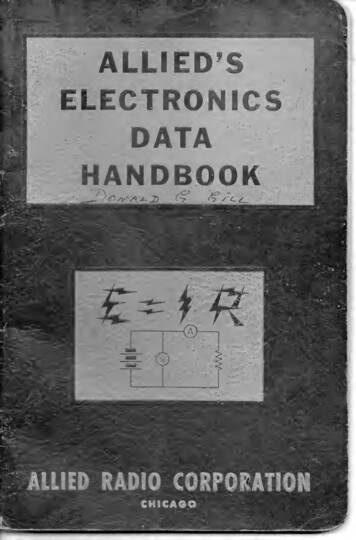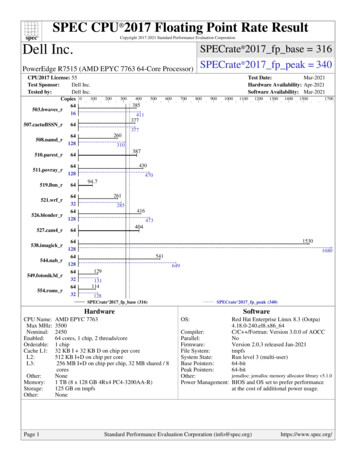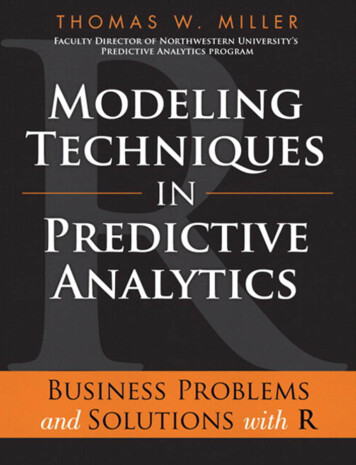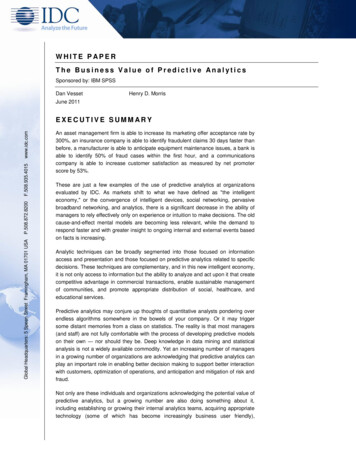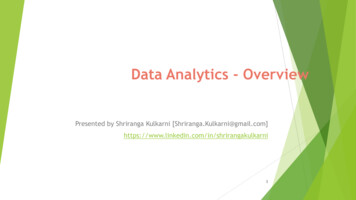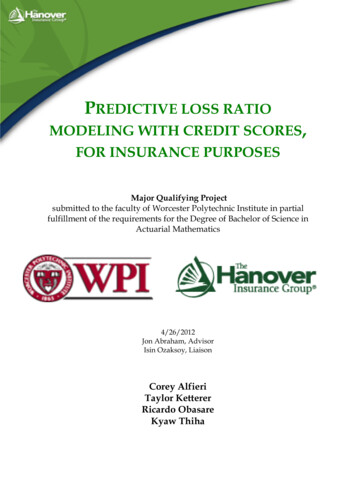
Transcription
PREDICTIVE LOSS RATIOMODELING WITH CREDIT SCORES,FOR INSURANCE PURPOSESMajor Qualifying Projectsubmitted to the faculty of Worcester Polytechnic Institute in partialfulfillment of the requirements for the Degree of Bachelor of Science inActuarial Mathematics4/26/2012Jon Abraham, AdvisorIsin Ozaksoy, LiaisonCorey AlfieriTaylor KettererRicardo ObasareKyaw Thiha
TABLE OF CONTENTSACKNOWLEDGEMENTS . 3EXECUTIVE SUMMARY . 4INTRODUCTION. 6BACKGROUND . 9HANOVER INSURANCE BACKGROUND . 9PREDICTIVE MODELING . 10CREDIT SCORE USAGE IN INSURANCE . 11GOVERNMENT REGULATORY ENVIRONMENT . 14MULTIVARIATE MODELS . 14GENERALIZED LINEAR MODELS . 14DECISION TREE ANALYSIS. 16MULTIVARIATE ADAPTIVE REGRESSION SPLINES (MARS). 16MODEL DISTRIBUTION TYPE: TWEEDIE DISTRIBUTION . 17METHODOLOGY . 19ANALYSIS AND DISCUSSION . 251.2.3.4.5.6.7.8.FINANCIAL STABILITY LOSS RATIO RELATIVITIES . 26POLICY TYPE LOSS RATIO RELATIVITIES. 27BUSINESS TYPE LOSS RATIO RELATIVITIES . 28MARKET SEGMENT LOSS RATIO RELATIVITIES . 29FLEET SIZE LOSS RATIO RELATIVITIES . 30POLICY EFFECTIVE AGE LOSS RATIO RELATIVITIES . 31C-POINTS LOSS RATIO RELATIVITIES. 32F-POINTS LOSS RATIO RELATIVITIES . 33CONCLUSIONS AND RECOMMENDATIONS . 34APPENDIX A: GLOSSARY. 37APPENDIX B: PROCESS OVERVIEW CHART . 39APPENDIX C: COMMERCIAL AUTO CHARTS . 40FINANCIAL STABILITY LIFT CHARTS . 40BUILD SAMPLE . 40VALIDATION SAMPLE . 40POLICY TYPE LIFT CHARTS . 41BUILD SAMPLE . 41VALIDATION SAMPLE . 411
BUSINESS TYPE LIFT CHARTS . 42BUILD SAMPLE . 42VALIDATION SAMPLE . 42MARKET SEGMENT LIFT CHARTS . 43BUILD SAMPLE . 43VALIDATION SAMPLE . 43FLEET SIZE LIFT CHARTS . 44BUILD SAMPLE . 44VALIDATION SAMPLE . 44POLICY EFFECTIVE AGE LIFT CHARTS . 45BUILD SAMPLE . 45VALIDATION SAMPLE . 45C-POINTS LIFT CHARTS . 46BUILD SAMPLE . 46VALIDATION SAMPLE . 46F-POINTS LIFT CHARTS . 47BUILD SAMPLE . 47VALIDATION SAMPLE . 47FINANCIAL STABILITY LIFT CHARTS . 48BUILD SAMPLE . 48VALIDATION SAMPLE . 48APPENDIX D: BUSINESS OWNER’S POLICY CHARTS. 49APPENDIX E: MODEL COEFFICIENTS . 59COMMERCIAL AUTO . 59BUSINESS OWNER’S POLICY . 60APPENDIX F: CODE . 61COMMERCIAL AUTO . 61DATA PREPARATION . 61FITTING . 61LIFT CHARTS . 62BUSINESS OWNERS POLICY . 63REFERENCES . 642
ACKNOWLEDGEMENTSOur team would like to first thank our sponsor The Hanover Insurance Group andthe entire team working there; without them, the idea for this project would not haveexisted. We would especially like to thank Isin Osaksoy and Marc Cournoyer for all theirguidance and support throughout the duration of our project. Additionally, we would liketo thank the Commercial Auto team; Jaris Wicklund and Andrew Evans; as well as theBusiness Owners Policy team; Jonathon Blake, Alyssa Potter and Chen Li. We are verygrateful to these individuals for assisting us in shaping the direction of our project and fortheir willingness to share their knowledge and expertise on the insurance industry. Finally,we would like to thank Professor Jon Abraham for constantly pushing us to do our best andfor his continued support when we faced challenges along the way. We also extend ourthanks to everyone at Worcester Polytechnic Institute (WPI) and The Hanover InsuranceGroup that made this experience possible.3
EXECUTIVE SUMMARYHanover Insurance Group is a publicly traded property and casualty insurancecompany that is based in Worcester, Massachusetts. They provide their customers with awide range of insurance products for both personal and commercial business lines. In recenttimes, credit scores have gained widespread popularity within the insurance industry,especially in the underwriting and pricing, due to its powerful predictive value. HanoverInsurance commissioned a team of four students from Worcester Polytechnic Institute (WPI)to design a statistical model that incorporates the credit score of each policy to better predictthe future level of risk associated with this policy.The goal of this project was to create a loss ratio model that would improve thepredictive ability of the current Hanover premium model through implementation of creditscores. This would enable Hanover to benefit from more informed underwriting and pricingtechniques, greater competitive advantage in commercial insurance lines of business andmost importantly, more robust underwriting profit. Steps included: Conducting weekly meetings with the project advisors to interpret andanalyze weekly results. Utilizing statistical software such as Microsoft Excel, SAS and R to analyzeand model data. Developing graphical charts of variables that are statistically significant to themodel, in order to determine model accuracy. ricingtechniques.The methodology consists of 3 primary steps. Our first step was to analyze thecurrent techniques that Hanover employs in pricing and underwriting. This was done inorder to identify the risk factors considered and to develop a solution to uniquely address4
their business issue. Our next step was to familiarize ourselves with the data set to detectdata quality issues and prepare the data for modeling. It is vital that the data be cleanedbefore usage as our model’s predictive ability depends primarily on the quality of the inputdata. We noted any outliers, missing data, and inconsistent or invalid data points andidentified statistically significant variables to be used in the model. Once we completed ourdata preparation we proceeded with the final step, data modeling. We used a generalizedlinear model with Tweedie distribution to predict the loss ratios of the policies, and usedtrial and error methods to test model accuracy. Once we were satisfied with the model, weanalyzed the results to develop appropriate risk categories to differentiate customers basedon the level of risk indicated by their predicted loss ratio.The purpose of this project was to improve Hanover’s underwriting and pricingtechniques through the implementation of credit scores. We believe that Hanover’s usage ofthese credit scores combined with additional company specific data, will be a powerful toolin predicting incurred loss ratio of a policy. Incorporating these credit scores will ensure thatHanover’s underwriting and pricing techniques are competitive and more advanced thansimilar companies within commercial insurance. Hanover’s ability to better differentiate therisk types of their customers will ultimately improve their underwriting profit by ensuringthat they do not underwrite policies with excessively high risk.5
INTRODUCTIONThe relatively recent integration of credit score information since the late 20thCentury has significantly impacted the insurance industry; however its usage has resultedin some level of controversy (Wu & Guszcz, 2003). A credit score is a numeric valuedeveloped using statistical methods used to represent a customer’s level of credit worthinessor ability to repay financial obligations. In insurance, credit scores have been used withadditional variables (driver record, type of vehicle, location of vehicle, etc.) to establishrelationships between individual responsibility and probability of a loss in the future. Theunderlying assumption here is that customers who are more responsible in managingpersonal finances will also be prudent in management of other aspects of their life. Thesetraits would lead insurance underwriters to believe that customers with a respectable creditscore will be low risk customers, hence making them desirable (Hartwig & Wilkinson, 2003,Wu & Guszczs, 2003). If an insurance company can better classify low and high riskcustomers from a pool of applicants, it can prevent them from taking on risky customerswho will have more claims and cause the company to make more payouts in the future.Therefore more and more companies in the insurance industry have begun to harness thepredictive value of credit information.In spite of this widespread usage, there have been several concerns raised over theextent to which credit scores are an accurate predictive measure. Credit scores are generatedusing a combination of past credit behavior of a consumer; therefore there is an issue as towhether its usage can be used to conclusively represent their behavior in the future. Severalstudies have, however, indicated that a relationship does exist between credit scores andloss frequency. Furthermore, the inclusion of credit scores in combination with othervariables increases the accuracy. Many consumers have challenged the link between creditscores and customer creditworthiness since a poor credit score can put them at a significant6
disadvantage when seeking to purchase insurance. As a result of this the government hasplaced restrictions and regulations on the manner in which insurance companies can usecredit information. Nonetheless, its continued usage attests to the fact that there is valuableinformation that can be gained by using credit information, which will ultimately serve toimprove the financial position of a business (Hartwig & Wilkinson, 2003) (Wu & Guszcz,2003) (Hanover Insurance Group, 2011).The Hanover Insurance Group is a publicly traded property and casualty insuranceprovider that is looking to utilize consumer credit information to improve underwritingprofit. Headquartered in Worcester, Massachusetts, Hanover focuses on providingcomprehensive insurance products to consumers in personal and commercial business lines.Their core commercial business segments can be further broken down into commercial autoinsurance, commercial property and liability insurance, worker’s compensation insuranceand other forms of specialized insurance packages (Hanover Insurance Group, 2011).Within the insurance industry, great emphasis is placed on developing techniques that allowfor more accurate modeling and prediction of risk. As business trends have developed, therehas been a noticeable shift to the inclusion of credit score data as a predictive measure of thelikelihood of losses associated with a customer account. Innovative implementation of acredit score variable would allow Hanover to enhance their current pricing andunderwriting mechanisms giving them a competitive advantage. This directly influencesHanover’s long-term profitability and market control and as a result has a key businessvalue to the firm. The business issue is therefore how the implementation of creditinformation can improve the predictive ability of the current Hanover premium model forthe commercial lines of business.This paper will outline the details surrounding the business issue facing the HanoverInsurance Group and the development of the solution. We will discuss the initial appearanceof credit information in the insurance industry and how it has been used in predictive7
modeling. Afterwards, we will indicate typical statistical models that have been used toconduct predictive analysis. From there, we will outline specific project goals and objectivesand the approach that was taken to achieve them. Following this, we will display the resultsof the model, highlighting key points and trends and analyzing the significance that themodel results have for the Hanover Insurance Group. At this stage, it will be necessary tounderstand the implications of implementing this model and additional future concerns thatmay affect the manner in which business is conducted at the Hanover Insurance Group.8
BACKGROUNDHanover Insurance BackgroundThe Hanover Insurance Group is a property and casualty insurance company basedin Worcester, Massachusetts. They have over four thousand employees and offer a widerange of products spanning personal and commercial lines of business. In addition, they area holding company for a group of insurers, offering property and casualty products andservices through a group of independent agents.Within personal lines, Hanover offers home insurance, with four levels of coveragefrom basic to select premium. Basic coverage offers replacement benefits for most commoncauses of loss. In addition, it insures other structures such as sheds and garages, covers somepersonal belongings, handles liability claims, and offers medical payments to non-householdmembers injured on the property. Each additional policy offers more coverage in addition tothe basic coverage. Hanover also offers personal auto insurance, which offers variousliability limits in addition to comprehensive and collision options, roadside assistance,transportation expense, medical payments and personal injury protection, and value-addedendorsements. For personal insurance customers who already have home or auto insurance,Hanover offers personal add-ons. The add-on called “Toys” covers recreational vehicles,watercraft insurance, and account extras. Umbrella Coverage provides additional coverageon top of the original policy, the Identity Integrity Program protects against identity theft,and valuables insurance is also offered.Hanover offers both small business insurance and midsize business insurance. Forsmall business insurance, there is standard insurance that inclu
Utilizing statistical software such as Microsoft Excel, SAS and R to analyze and model data. Developing graphical charts of variables that are statistically significant to the model, in order to determine model accuracy. Recommendations f
